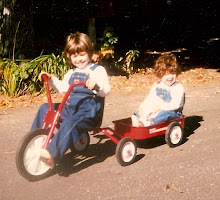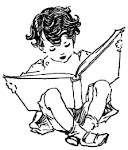A Child's Calendar
By John Updike
Illustrated by Trina Schart Hyman
Book Summary:
There are 12 poems in this book, with one for each month, that are accompanied by full-page illustrations and smaller pictures beside each poem. Updike's poems are told through the activities played out by a loving and affectionate interracial stepfamily, which includes, a black father, white mother, two black children, and two white children. The poems in the story represent the seasonal changes take place from month to month and season to season, as well as the activities that people do during that time of year. The language of the poems is very basic and simple, which makes it simple for younger children to understand.
There are 12 poems in this book, with one for each month, that are accompanied by full-page illustrations and smaller pictures beside each poem. Updike's poems are told through the activities played out by a loving and affectionate interracial stepfamily, which includes, a black father, white mother, two black children, and two white children. The poems in the story represent the seasonal changes take place from month to month and season to season, as well as the activities that people do during that time of year. The language of the poems is very basic and simple, which makes it simple for younger children to understand.
Lesson: In Which Season Were You Born?
Lesson Duration: 40 minutes.
Standards addressed: Science, Language Arts, & Math:
Standard: K-4: The student will demonstrate an understanding of seasonal weather changes.
Indicators: K-4.2: Compare the weather patterns that occur from season to season.
Standard K-2: The student will begin to read and comprehend a variety of informational texts in print and non-print formats.
Indicator:K-2.1: Summarize the central idea and details from informational texts read aloud.
Standard: K-6: The student will demonstrate through the mathematical processes an emerging sense of organizing and interpreting data.
K-6.2: Interpret data from a graph.
Lesson Objectives:
-The student will acquire knowledge about the connection between months and seasons, demonstrating a comprehension that months fall under seasons.
-The student will ask questions about the text and begin to think about and infer meaning behind poems.
-The student will begin to organize data on a graph.
-The student will begin to interpret and analyze data on a graph.
Materials:
Materials:
- Updike, John. (2000). A Child’s Calendar. New York, New York: Robins Lane Press.
-Graph template handouts.
-SMART board software
-Projector.
-Smart board screen.
-A computer.
-Crayons
-A wall Calendar.
-A Flip Chart with grids.
-A Sharpie.
-Pencils.
-A Class list matrix.
-A clipboard.
-The names of the months and seasons written out on a whiteboard.
-Dry erase marker.
Introduction:
[The class and the teacher will be seated on the carpet in a circle].
1. The teacher will ask the student, “What Season are you born in?”
2. Expecting puzzling looks and after pausing to give the student time to answer, the teacher will ask again:Does anyone know what season he/she was born in?
3. The teacher will explain that each month is part of one of the four seasons.
 4. The teacher will activate prior knowledge from what the student has learned from doing calendar activities, by asking the student how many months there are in a year and the names of the month in order. The teacher will write the names of the months on the whiteboard and then ask the student to recall the four seasons and name them aloud for the teacher. The teacher will then write the seasons on the whiteboard as well.
4. The teacher will activate prior knowledge from what the student has learned from doing calendar activities, by asking the student how many months there are in a year and the names of the month in order. The teacher will write the names of the months on the whiteboard and then ask the student to recall the four seasons and name them aloud for the teacher. The teacher will then write the seasons on the whiteboard as well.
5. The teacher will introduce the book, A Child’s Calendar, and tell the student to listen to the descriptions of the Months in each of the Poems because there is one poem for each month and there may be hints to which season the month belongs.
 6. The teacher will say: Think about this and raise your hand when I am done with one month because I will stop after each poem and see if you think you know the season that month belongs to. I will only call on those students who are listening and not talking while I read, who are respecting those around them, and how are quietly sitting on their bottoms and raising their hands.
6. The teacher will say: Think about this and raise your hand when I am done with one month because I will stop after each poem and see if you think you know the season that month belongs to. I will only call on those students who are listening and not talking while I read, who are respecting those around them, and how are quietly sitting on their bottoms and raising their hands.
 7. The teacher will read the book, A Child’s Calendar, aloud to the class. As the teacher finishes each poem, she will pause and ask the student if he/she knows the season of that month. The teacher will write the student’s guesses/ideas on the whiteboard under the month or season.
7. The teacher will read the book, A Child’s Calendar, aloud to the class. As the teacher finishes each poem, she will pause and ask the student if he/she knows the season of that month. The teacher will write the student’s guesses/ideas on the whiteboard under the month or season.8. When the teacher is done reading the book, she will look through what the students have guessed. The teacher will flip through the pages of the book and ask the student to recall how the author/poet described each season. The teacher will try and guide the student toward the correct season.
9. The teacher will then tell students the correct answers and write them next to the student’s guesses on the whiteboard.
10. The teacher will then ask the students, “Now does everyone know what season he/she was born?”
11. The teacher will ask if child to tell the class his/her birthday month/day and then in which season he/she is born.
12. The teacher will then have the student return to his or her desk to do a math activity.
Procedure:
1. Once the class has returned to their desks, the teacher will tell the students that they are going to be graphing some data today. The teacher will ask the student what he/she thinks they could be graphing based on what was discussed with the book.
 2. The teacher will explain that today the class will be graphing the seasons that each of the students in the class was born in.
2. The teacher will explain that today the class will be graphing the seasons that each of the students in the class was born in.
3. The teacher will explain that first the teacher will demonstrate how to collect data and then fill out a graph by having each student to predict which season will be the most popular season to be born in within the class. The teacher will tell the students after that has been modeled that the teacher will help the student collect data from the class and that the student will be making his/her own graph of the data.

 4. The teacher will ask each student to come up to the SMART board and chose a season that the student thinks will be the most popular and drag his/her prediction onto a graph. Using SMART board, the teacher will demonstrate how the data is collected and then how easily the graph is created. The teacher will explain that the names of the season are across the bottom of the graph and the numbers of predictions are along the left side going up the paper. The teacher will demonstrate how she analyzes the graph and ask the student which season most students predicted.
4. The teacher will ask each student to come up to the SMART board and chose a season that the student thinks will be the most popular and drag his/her prediction onto a graph. Using SMART board, the teacher will demonstrate how the data is collected and then how easily the graph is created. The teacher will explain that the names of the season are across the bottom of the graph and the numbers of predictions are along the left side going up the paper. The teacher will demonstrate how she analyzes the graph and ask the student which season most students predicted.5. The teacher will then hand out a graph template to each student that is already set up.
6. The teacher will explain that she wants the student to now find out which is actually the most popular season that birthdays fall in so that they can compare it to the student’s predictions.
7. The teacher will have each student come up to the SMART board and under his/her name move a symbol: a sun for summer, a flower for spring, a snowflake for winter, and a orange leaf for fall. The teacher will remind the student that the information about seasons and months is still on the board if the student cannot remember what season his/her birthday falls into and if they are unsure he/she can ask the teacher for help.
 8. Once all the data is collected the teacher will tell the student that he/she may work with his/her group and color in the boxes according to the data.
8. Once all the data is collected the teacher will tell the student that he/she may work with his/her group and color in the boxes according to the data.9. The teacher will pass out crayons and walk around, providing scaffolding to the student. The teacher will make notes about observations that she notices on the class matrix by carrying around a clipboard while she helps students.
10. Once all groups have completed their graphs, the teacher will have the students help her fill out a graph on SMART board that is the same version as the one the student has created. The teacher will ask the student to guide her through the process and then one the graph is filled out the teacher will ask the student what the graph is showing and what the students notice.
11. The teacher will then ask the student to compare this graph with the predictions graph by putting them both up on the SMART board next to each other.
12. The teacher will ask student to now reflect on the poems and think about the month of his/her birthday and think about the weather and the things the student does around his/her birthday. The teacher will have the students sit in groups of students that are born in the same season and ask them to share.
13 The teacher will then ask the groups to share with the rest of the class.
14. The teacher will then wrap up the lesson by reviewing the months that fall under each season and asking the student to identify them. The teacher will do this by asking the students to return to the carpet and calling on students who are raising their hands and sitting criss-cross on their bottoms.




























No comments:
Post a Comment